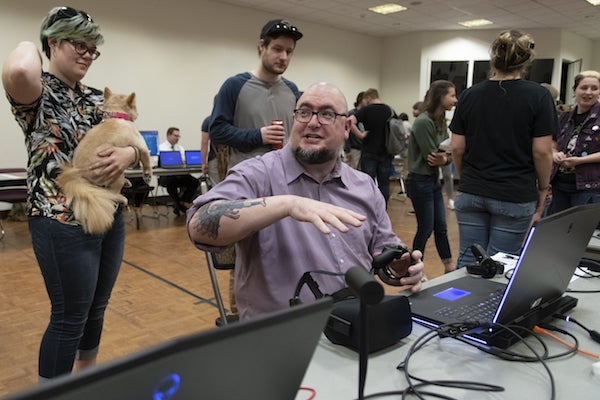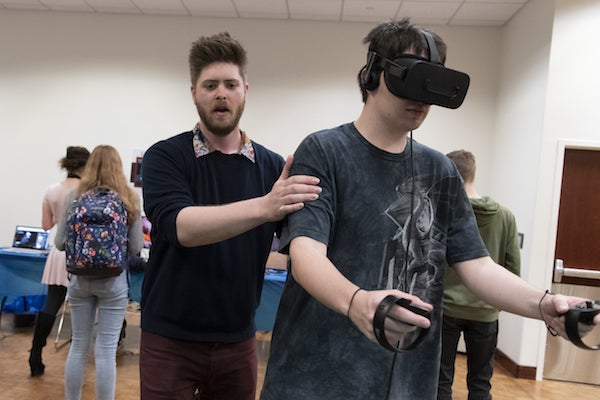
Gaming, Interactive Media, and Mobile Technology (GIMM) has a lot to celebrate as the academic year comes to an end. It expanded its lab at Albertsons Library. It’s making strong and diverse connections with the community beyond campus, and it’s graduating its first class of 22 students, with another 10 students slated to graduate next semester. Class size has increased steadily since the GIMM degree opened in 2015 in the College of Innovation and Design.
“We’ve been one of the fastest growing majors on Boise State’s campus,” said GIMM Director Anthony Ellertson. He anticipates 240 GIMM majors enrolled in the fall.
The program prepares students for jobs as mobile app and web developers, video game designers and more. Students work with organizations and companies to find high-tech solutions for issues they’re facing. The program pays students for the work they do.
Over the past four years, GIMM has stayed true to its mission of “creating a seamless pipeline between ourselves and industry,” Ellertson said. He estimates that a third of the new graduates already have found jobs.
Exploring unknown territory
One student, Aaron Gluck, is headed back to school after graduating this spring. He’ll pursue a Ph.D. in the Human Centered Computing program at Clemson University in South Carolina. A professor there invited Gluck to join a team working on technology to help people with visual impairments operate self-driving cars. Thinking about those future clients inspired Gluck to create the project he showed off at the GIMM Senior Showcase on campus in March – a virtual reality (VR) experience called The Enclosing Dark. It doesn’t require sight, but is entirely based on sound.
“Virtual reality auditory adventure for people with visual impairments is a new field that no one’s touched yet,” said Gluck.
Ultimately, Gluck wants to study VR and the possibility that it could cause trauma for people who encounter ever more realistic and terrifying digital scenarios. That’s another largely unexplored field, he said.
Gluck joined the GIMM program after starting his college career in California 25 years ago “when a major like GIMM didn’t exist yet.” After moving to Idaho, feeling stuck in an uninspiring job and looking for a new direction, he remembered his youthful passion for making board games – old-style, with actual boards and game pieces. He credits his wife, Karin Gluck, with finding the GIMM major at Boise State and urging him to apply. He enrolled and spent a year catching up, taking four GIMM classes a semester.
“It was intense, a lot of weeks of four-hours-a-night sleep,” said Gluck. “But I love the work, so it never felt like a struggle. It was always, ‘This is fun.'”
Still, he warns anyone considering GIMM to not jump to conclusions because “games” is in the major’s title.
“I used to play video games. I haven’t played in a couple years – other than testing the games I made myself, or games a friend made,” he said.
Ellertson said that GIMM welcomes between 130 and 140 potential majors each year. About 40 percent of those students drop the major quickly when they realize the work required and the “professional pace” of the classwork.
“When we say each class requires 10 hours of work outside of class, they think we’re kidding,” said Ellertson.
But after that initial drop, retention rates are high, he said.
Students for whom GIMM is a fit thrive in atmospheres like the Friday lab. It’s a kind of creative hothouse at Albertsons Library that Ellertson has often likened to “Hogwarts” of Harry Potter fame. During lab, students and faculty work together on projects. They share ideas in a communal space that’s intense, social and often unpredictable.
“There’s always someone there, and seeing that collaboration is amazing,” said Gluck. “You see the synergy. The whole is greater than the parts. You walk around, see things you never would have thought about and your jaw hits the ground.”
Games for good
GIMM graduate Aaron Christensen started his collegiate career elsewhere in 2010, but didn’t find what he was looking for, he said. He immersed himself in art and music. He came to Boise State in 2015 and began studying biology. He wanted to pair that with a skill like coding. As soon as he found out about GIMM, he knew it was a fit. Like Gluck, he doubled down on classes to catch up.

GIMM doesn’t focus on grades and other traditional measurements as much as it focuses on making sure students leave the program with a portfolio of six to eight industry-level projects to show potential employers. After graduation, Christensen will refine his portfolio, then start applying for jobs.
“Ideally, I want to go into game design, working on creative projects, telling narratives,” he said.
He’s working to build an interactive app that helps people facing some kind of challenge, like physical rehabilitation. He envisions an app that could “game-ify” rehab, guide people through a series of stretches, for example, then provide some kind of reward. At the March showcase, he shared Garden Defender, a VR game in which virtual gardeners use salt to kill snails that are eating their flowers. Christensen designed the game to help people new to VR get accustomed to moving around in the digital space.
“I wanted to flex my abilities as a game designer, consider my audience and make something that would be fun, easy to pick up and interact with,” he said. “VR isn’t something you’re usually in for more than 10 minutes. But I’ve had people play this game for 45 minutes, until they’re entirely overrun with snails.”
He’s created other puzzle games. Watching players struggle, then seeing their looks of realization when they find the solution, gives Christensen incredible satisfaction, he said.
Looking toward the future
This year, GIMM joined forces with the Old Coot and Maggie Foundation in Boise to create a portfolio of high-tech solutions for community based problems. It’s an ongoing relationship, said Ellertson, that will provide $250,000 per year to the program, including salaries for students. Christensen worked on the inaugural project. He was part of the team that collaborated with artist Becka Watkins to create an interactive digital gallery in which Watkins’ art and narrative trace her recovery from an eating disorder. The gallery will be available to the public in the near future. The partnership’s next project will center on literacy for the deaf.
GIMM has worked on projects with Daimler Automotive, Idaho National Laboratories, the Idaho State Historical Society and on an award-winning VR training programs for nurses, to name a few. GIMM has upcoming projects with Idaho Fish and Game to attract more people to fishing and hunting culture, and other projects on campus that will help student retention and curb food waste. And it continues to look to the future with an active outreach program in local elementary, middle and high schools.
“We’re always asking, what’s the role of a university in a community?,” said Ellertson. “We shouldn’t be an ivory tower. If we are, we’re in trouble. If someone comes to us with a problem, we realize the things we learn are applicable to those problems in so many ways.”